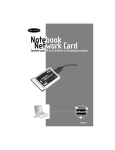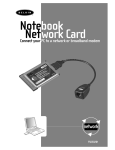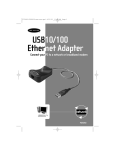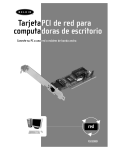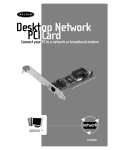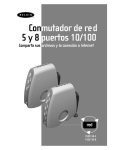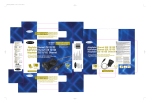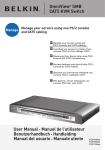Download Belkin F5D5010 Product specifications
Transcript
P73635-F5D5010-man.qxd 6/4/01 4:54 PM Page 1 Notebook Network CardBusCard Connect your PC to a network or broadband modem network F5D5010 P73635-F5D5010-man.qxd 6/4/01 4:54 PM Page 2 P73635-F5D5010-man.qxd 6/4/01 4:54 PM Page 3 Table of Contents Introduction . . . . . . . . . . . . . . . . . . . . . . . . . . . . . . . . . . . . . . . . .1 Installing the Hardware . . . . . . . . . . . . . . . . . . . . . . . . . . . . . . . . .2 Installing the Network Drivers . . . . . . . . . . . . . . . . . . . . . . . . . . .3-5 Connecting to a DSL or Cable Modem . . . . . . . . . . . . . . . . . . .6-13 Creating a Simple Network . . . . . . . . . . . . . . . . . . . . . . . . . . .14-28 Sharing an Internet Connection . . . . . . . . . . . . . . . . . . . . . . . .29-46 Product Specifications . . . . . . . . . . . . . . . . . . . . . . . . . . . . . . . . .47 Warranty, FCC, CE Statement . . . . . . . . . . . . . . . . . . . . . . . . . . . .48 P73635-F5D5010-man.qxd 6/4/01 4:54 PM Page 1 Introduction Congratulations on your purchase of this quality Belkin product. You can now enjoy the benefits of sharing printers and peripherals, exchanging data quickly between connected computers, and communicating via e-mail and the Internet. This guide explains how to install and use the Belkin Notebook Network CardBus Card on a PC running Microsoft® Windows® 98, 2000, NT® 4.0, or Me operating system software. Features: • Compatible with PCMCIA CardBus specification • Provides LED indicators for monitoring network traffic Contents of Package: • One Notebook Network CardBus Card • One CD-ROM • User Guide 1 P73635-F5D5010-man.qxd 6/4/01 4:54 PM Page 2 Installing the Hardware Installing the Notebook Network Card in PCs with CardBus Slots 1. Turn off the power to the notebook. 2. Insert the Notebook Network Card in the CardBus slot of your notebook. 3. Connect the Notebook Network Card’s adapter into the connector on the rear of the card. 4. Connect the other end of the CAT5 cable and RJ45 plug into the network device. Note: A standard Belkin network cable cannot be used to directly connect two computers. A specially wired cable called a crossover cable is needed to allow you to connect two computers without the use of a network hub or switch. Belkin crossover cables are yellow (Belkin’s A3X126-XX-YLW-M). 2 P73635-F5D5010-man.qxd 6/4/01 4:54 PM Page 3 Installing the Network Drivers Installing the network drivers Now that you have properly installed the Notebook Network CardBus Card and it is properly connected to the network, we are now ready to configure the software to allow your computers to work together efficiently. 1. Turn on the power to the PC. Windows will automatically detect that a new device has been installed and will display the following window: 2. The "Add New Hardware Wizard" will begin: 3. Click the Next button. 3 P73635-F5D5010-man.qxd 6/4/01 4:54 PM Page 4 Installing the Network Drivers 4. When asked, "What do you want Windows to do?" select the first option- "Search for the best driver for your device.(Recommended)" and click the Next Button. 5. Select the CD-ROM drive box. Place the CD-ROM supplied with the card in your CD-ROM and click the Next Button. 4 P73635-F5D5010-man.qxd 6/4/01 4:54 PM Page 5 Installing the Network Drivers 6. The following screen will appear: 7. Click the Next Button and the following screen will appear: 8. Click on the Finish Button to complete the wizard. Your computer may prompt you to restart, if so, allow the system to restart. 5 P73635-F5D5010-man.qxd 6/4/01 4:54 PM Page 6 Connecting to a DSL or Cable Modem Many DSL or cable modems require connection to a computer through a network interface card (NIC). To determine if your cable or DSL modem can be connected through a network interface card, you can either consult your modem’s documentation or simply look at the ports on the back of the modem. If your modem has a port that looks just like the one pictured below (similar to a standard phone jack, but a little larger), then the Belkin Notebook Network CardBus Card is an easy way to connect to these modems and take advantage of high-speed Internet access. 10/100Base-T Ethernet Connector Connecting the hardware To connect the modem to your Network Card, you will need an Ethernet "patch cable," or "CAT5 cable". Most cable and DSL modems will require connection using a "crossover patch cable," however, some modems offer a second network connector labeled "Computer," which can be connected to the Network Card using a standard patch cable. To determine which cable to use, it is recommended that you consult your modem’s installation guide or user manual. 6 P73635-F5D5010-man.qxd 6/4/01 4:54 PM Page 7 Connecting to a DSL or Cable Modem Belkin offers a full line of these cables, available from any major retailer or distributor of computer-related products. To achieve the best performance from your Cable or DSL modem, we recommend the following part numbers: Crossover Ethernet Patch Cable: A3X126-xx-YLW-M, where "xx" denotes the cable length in feet FastCAT5e Ethernet Patch Cable: A3L850-xx-yyy-S, where "xx" denotes the length, and "yyy" denotes the color of the cable To connect your DSL or cable modem to the computer, make sure you have first installed both the Belkin Notebook Network CardBus Card and its drivers as detailed earlier in this manual. Once the hardware and drivers are installed, plug one end of the Ethernet Patch Cable to the connector on the Network Card, and plug the other end into the connector on the modem. Configuring your computer Once the computer is connected to your DSL or cable modem, you will need to configure your computer’s network settings to access the Internet using the modem. Note: This section includes general instructions for configuring your computer to use a DSL or cable modem, which work for most DSL and cable service providers; however, some providers have special requirements or non-standard configurations. If your DSL or cable provider has provided instructions which differ from this, please follow those instructions. If the procedure below does not work for you, please contact your DSL or cable provider for instructions on configuring your computer to use the modem. 7 P73635-F5D5010-man.qxd 6/4/01 4:54 PM Page 8 Connecting to a DSL or Cable Modem When you use a DSL or cable modem, you are connecting to your service provider’s network. These networks can be set up by the provider to communicate with your computer using either "dynamic" or "static" addressing. To configure your computer, you will need to know which of these methods is to be used. If your provider intends for you to use "static" addressing, they should have provided you with several Internet addresses (labeled "IP address", "Net Mask", and one or more "DNS addresses"), each of which looks similar to the following: 192.168.0.1. If you did not receive numbers such as this in the paperwork or documentation accompanying your modem, your provider likely intends to use "dynamic" addressing. Using static addressing To access the Internet using static addressing, configure the network settings for your computer as follows: 1. Open the Control Panel: click on the Start button, click on Settings, and choose Control Panel from the menu that pops out. 2. Double-click on the Network icon in control panel to open the Network window. 8 P73635-F5D5010-man.qxd 6/4/01 4:54 PM Page 9 Connecting to a DSL or Cable Modem 3. In the list of network components, click on the line that says: "TCP/IP -> 32-bit PCI Fast Ethernet Adapter" –or"TCP/IP -> Realtek RTL…" 4. Click on the Properties button to open the TCP/IP Properties window. 5. Click on the IP Addresses tab. 6. Select "Specify an IP address", and fill in both the "IP Address" and "Subnet Mask" fields with the numbers supplied by your service provider. 7. Click on the DNS Configuration tab. 9 P73635-F5D5010-man.qxd 6/4/01 4:54 PM Page 10 Connecting to a DSL or Cable Modem 8. Select "Enable DNS". 9. If your service provider has supplied a "Host Name" and/or "Domain", fill in these fields. 10.For each DNS address your service provider has supplied, add the address in the "DNS Server" section. 11.Click OK to close the TCP/IP Properties window. 12.Back in the Network window, scroll through the list of network components. If "File and Printer Sharing for Microsoft Networks" is on the list, we strongly recommend removing it before using a DSL or cable modem connection. Using File and Printer Sharing makes it easier for other people on the Internet to access files on your computer without your knowledge or consent, with potentially harmful results. Check with your service provider for their own specific security recommendations. 13.Click OK to close the Network window. 14.Windows will ask you to restart your computer. Please do so. Once you have restarted your computer, do the following: 1. Right-click on the "Internet Explorer" icon on your desktop to bring up its context menu, and select Properties. 2. Select the "Connections" tab. 3. Under "Dial-up settings", choose "Dial whenever a network connection is not present". 10 P73635-F5D5010-man.qxd 6/4/01 4:54 PM Page 11 Connecting to a DSL or Cable Modem 4. Click OK to close the window. You should now be able to open Internet Explorer and access the Internet at high-speed through your DSL or cable connection. If your browser is unable to connect to the Internet, please contact your service provider for further information. Using dynamic addressing To access the Internet using dynamic addressing, configure the network settings for your computer as follows: 1. Open the Control Panel: click on the Start button, click on Settings, and choose Control Panel from the menu that pops out. 2. Double-click on the Network icon in control panel to open the Network window. 11 P73635-F5D5010-man.qxd 6/4/01 4:54 PM Page 12 Connecting to a DSL or Cable Modem 3. In the list of network components, click on the line that says: "TCP/IP ->32-bit PCI Fast Ethernet Adapter" –or"TCP/IP -> Realtek RTL…" 4. Click on the Properties button to open the TCP/IP Properties window. 5. Click on the IP Addresses tab. 6. Select "Obtain an IP address automatically." 7. Click OK to close the TCP/IP Properties window. 8. Back in the Network window, scroll through the list of network components. If "File and Printer Sharing for Microsoft Networks" is on the list, we strongly recommend removing it before using a DSL or cable modem connection. Using File and Printer Sharing makes it easier for other people on the Internet to access files on your computer without your knowledge or consent, with potentially harmful results. Check with your service provider for their own specific security recommendations. 12 P73635-F5D5010-man.qxd 6/4/01 4:54 PM Page 13 Connecting to a DSL or Cable Modem 9. Click OK to close the Network window. 10. Windows will ask you to restart your computer. Please do so. Once you have restarted your computer, do the following: 1. Right-click on the "Internet Explorer" icon on your desktop to bring up its context menu, and select Properties. 2. Select the Connections tab. 3. Under "Dial-up settings", choose "Dial whenever a network connection is not present". 4. Click OK to close the window. You should now be able to open Internet Explorer and access the Internet at highspeed through your DSL or cable connection. If your browser is unable to connect to the Internet, please contact your service provider for further information. 13 P73635-F5D5010-man.qxd 6/4/01 4:54 PM Page 14 Creating a Simple Network If you have two or more computers in your home or office, connecting them via a network lets you cooperate, collaborate, and make the most of your hardware. You can share files, printers, and even access the Internet from all of your computers through your network. While networking was once a complicated matter, Windows 95, 98 and later versions, along with hardware like Belkin networking products have made networking very easy to do for everyone. The following section of this manual will help you set up a simple network in your home or office. If you are connecting to a larger, existing network, it is recommended that you consult your network administrator (the person who originally set up the network) for instruction on how to connect additional computers to the network. There is a wide variety of network hardware available, ranging from simple and inexpensive to very complex; however, for most home and small offfice network needs, the hardware required is basic. 14 P73635-F5D5010-man.qxd 6/4/01 4:54 PM Page 15 Creating a Simple Network Connecting two computers: PC Tower PC Tower Connecting two computers simply requires each computer to have a Network Card, such as the Belkin Notebook Network CardBus Card for notebook computers, or the Belkin Desktop Network PCI Card for desktop computers. Simply connect the two Network Cards using a crossover Ethernet patch cable, such as Belkin part number: A3X126-xx-YLW-M, where "xx" denotes the cable length in feet 15 P73635-F5D5010-man.qxd 6/4/01 4:54 PM Page 16 Creating a Simple Network Connecting three or more computers PC Tower PC Tower PC Tower Connecting three or more computers requires each computer to have a Network Card, such as the Belkin Desktop Network Card for desktop computers, or the Belkin Notebook Network CardBus Card for notebook or laptop computers. You should also have an 10/100Base-T hub or switch enough ports for the number of computers you intend to connect immediately or in the near future. Hubs and switches are physically and effectively very similar; however, Belkin always recommends the use of switches when possible (such as the Belkin 5-port Network Switch part number F5D5130-5, or the Belkin 8-port Network Switch part number F5D5130-8). Switches offer much higher performance, efficiency, and speed than standard hubs. After installing the network cards, connect each computer to the switch using an Ethernet CAT5 patch cable, such as Belkin part number: A3L850-xx-yyy-S, where "xx" denotes the length, and "yyy" denotes the color of the cable 16 P73635-F5D5010-man.qxd 6/4/01 4:54 PM Page 17 Creating a Simple Network Configuring your computers For each computer you connect to the network, you must set the network address to be used by other computers to communicate with this one. Follow these steps on each computer on the network to properly configure these settings: 1. Open the Control Panel: click on the Start button, click on Settings, and choose Control Panel from the menu that pops out. 2. Double-click on the Network icon in control panel to open the Network window. 17 P73635-F5D5010-man.qxd 6/4/01 4:54 PM Page 18 Creating a Simple Network 3. In the list of network components, click on the line that says: "TCP/IP -> 32-bit PCI Fast Ethernet Adapter" –or"TCP/IP -> Realtek RTL…" 4. Click on the Properties button to open the TCP/IP Properties window. 5. Click on the IP Addresses tab. 6. Select "Specify an IP address", and fill in the "IP Address" with the number 192.168.0.x, where "x" is a different number between 1 and 255 for each of your computers. 7. Fill in the "Subnet Mask" field with the number 255.255.255.0 8. Click OK to close the TCP/IP Properties window. 9. Click OK to close the Network window. 10. Windows will ask you to restart your computer. Please do so. 18 P73635-F5D5010-man.qxd 6/4/01 4:54 PM Page 19 Creating a Simple Network Configuring network software In order for your network to be configured properly there are four network components that must be present. Client for Microsoft Networks, 32-Bit PCI Fast Ethernet Adapter, TCP/IP- 32-Bit PCI Fast Ethernet Adapter, and File and Printer Sharing for Microsoft Networks should be set up. The following are the steps to follow: 1. From the Start menu go to Setting and select Control Panel. 2. Double-click on Network and the following screen will appear: Note: There may be several other items listed, especially if your computer has a modem installed. 19 P73635-F5D5010-man.qxd 6/4/01 4:54 PM Page 20 Creating a Simple Network 3. Click on the Add button, the following screen will appear: 4. Highlight Service on the list and press the Add button and select File and Printer Sharing for Microsoft Networks. 20 P73635-F5D5010-man.qxd 6/4/01 4:54 PM Page 21 Creating a Simple Network 5. If Client for Microsoft Networks does not appear in the Network Configuration screen, highlight Client on the list and once again press the Add button and the following screen will appear: 6. Select Microsoft as the Manufacturer, and Client for Microsoft Networks, and press OK. 7. After a few seconds the network configuration window will open again, press the Add button and add protocol if TCP/IP32-Bit PCI Fast Ethernet Adapter is not present, this time select Microsoft as the Manufacturer, and TCP/IP and press OK. 21 P73635-F5D5010-man.qxd 6/4/01 4:54 PM Page 22 Creating a Simple Network 8. The Network window will now look something like this: 9. The following network components should be installed: If all clients and protocols are not listed, press the Add button, and add the missing components. 10.Press the File and Printer Sharing button and check both boxes, then press OK. The screen will now look something like this: 22 P73635-F5D5010-man.qxd 6/4/01 4:54 PM Page 23 Creating a Simple Network 11. Press the Identification Tab, and then enter the details for the three fields. In order to share files each PC must have its own unique name, but belong to the same workgroup. 12. Press the Access Control tab, and set the access to share-level access control. Press the OK button. 23 P73635-F5D5010-man.qxd 6/4/01 4:54 PM Page 24 Creating a Simple Network Sharing files and disk drives 1. To share files and access to a hard drive, floppy drive, or CD-ROM with other computers on the network, open the My Computer window on the computer containing the files or drive you wish to share. RIGHT CLICK on the drive that you wish to share, then select Sharing from the menu that appears, and set the level of access that you want to allow. Accessing resources on other computers: 1. To access resources available on other computers, click on the Network Neighborhood icon on your desktop. 2. Double-click on the computer that you wish to access. 3. You can now access all the files that are available to you on your network. 24 P73635-F5D5010-man.qxd 6/4/01 4:54 PM Page 25 Creating a Simple Network Sharing a printer with the network 1. To share a printer with other computers on the network open the My Computer folder. 2. Double-click on the Printer folder, RIGHT CLICK on the printer that you wish to share, then select Sharing from the menu that appears. 3. Select the Shared As button to enable sharing of this printer. (You may also want to assign the printer a meaningful name.) Select Not Shared to disable printing by other computers to this printer. Using a shared printer on the network 1. To use a shared printer on another computer in the network open the My Computer folder. 2. Double-click on the Printers folder. 25 P73635-F5D5010-man.qxd 6/4/01 4:54 PM Page 26 Creating a Simple Network 3. Double-click on the Add a Printer button and the following screen will appear, click Next. 4. The screen will now look something like this. Select Network printer and click Next. 26 P73635-F5D5010-man.qxd 6/4/01 4:54 PM Page 27 Creating a Simple Network 5. The following screen will appear. 6. Type the network path or queue name or click on the Browse button. You can browse to see all printers available to share on the network. Select the shared printer and follow the wizard prompts. 27 P73635-F5D5010-man.qxd 6/4/01 4:54 PM Page 28 Creating a Simple Network 7. After the printer is installed the following icon will appear in the printers folder showing a network printer is installed. 28 P73635-F5D5010-man.qxd 6/4/01 4:54 PM Page 29 Sharing an Internet Connection Sharing a single Internet connection is one of the most useful advantages of networking your computers. Rather than having a modem, phone line, and perhaps even a separate Internet account for each of your computers, you can configure your network to allow all of your computers to share a single dial-up, DSL, or cable Internet connection. There are two ways to share an Internet connection, either by running Internet sharing software on a computer on the network which has a working Internet connection, or by using a special piece of hardware called a "Gateway". Software Internet sharing is appropriate for dial-up (normal phone line) Internet connections, as well as for DSL and cable connections which use either a modem which connects to the computer’s USB port, or a modem which goes inside of the computer. Software Internet sharing can be done through the Windows operating system if the computer which has the Internet connection is running Windows 98 SE, Me, NT 4.0., or 2000. If the computer with the Internet connection to be shared is running another operating system, third-party "proxy server" software is required. Hardware Internet sharing, which requires a Gateway (such as the Belkin Broadband Internet Gateway, part number F5D5230-X), is the best way to share DSL or cable Internet connections which use a modem connected to the Network Card in a computer. Once you have your network running properly, which can easily be verified by using Network Neighborhood to view the other computers on your network, and have a working Internet connection through a standard dial-up, DSL, or cable modem, setting up Internet connection sharing is simple. 29 P73635-F5D5010-man.qxd 6/4/01 4:55 PM Page 30 Sharing an Internet Connection Hardware Internet sharing Sharing of a single broadband Internet connection using a Gateway is the most efficient and highest-performance way of sharing a DSL or cable Internet connection. In addition, most Gateways provide a basic level of security for your network, and include a built-in switch to add more ports to your network. In fact, full-featured Gateways such as the Belkin Broadband Internet Gateway (part number F5D5230-X) can be used either in place of, or in addition to, any existing network hub or switch. Cable or DSL Modem Cable or DSL line PC Tower PC Tower PC Tower Network using Gateway in place of switch For full information on installing a Gateway and configuring internet access using it, please consult the user manual supplied with your Gateway. 30 P73635-F5D5010-man.qxd 6/4/01 4:55 PM Page 31 Sharing an Internet Connection Software Internet sharing If you have a working Internet connection on a computer running Windows 98 SE, Me, NT 4.0, or 2000, you can use the built-in Internet Connection Sharing capabilities of your operating system. On the computer which has the Internet connection follow these steps. Windows 98 SE host configuration 1. Open the My Computer window. 2. Double-click on the Control Panel and then double-click on Add/Remove Programs and press the Windows Setup tab and the following window will appear: 3. 4. 31 Double-click on Internet Tools. Select the check box on the Internet Connection Sharing and click OK. P73635-F5D5010-man.qxd 6/4/01 4:55 PM Page 32 Sharing an Internet Connection 5. Click Next and the following screen will appear: 6. Click Next and the following screen will appear: 7. Click Next again. 32 P73635-F5D5010-man.qxd 6/4/01 4:55 PM Page 33 Sharing an Internet Connection 8. When asked, "What type of connection do you use to access the Internet?" select the first option, "Dial Up Connection", and click Next. 9. Internet Connection Sharing will now create a Client Configuration Disk to configure the browsers on the other computers on your home network to use Internet Connection Sharing. 33 P73635-F5D5010-man.qxd 6/4/01 4:55 PM Page 34 Sharing an Internet Connection 10. Click the Next button and the following window will appear: 11. Insert a floppy disk into drive A and click OK. 12. You have now successfully created the Client Configuration Disk to configure the browser on the other computers of your home network. Windows 98 SE host configuration check 1. From the Start Menu go to setting and select Control Panel 2. Double-click on Network and the following screen will appear: Note: There are now a lot more entries in the Network configuration. 3. Change the Primary Network Logon to "Windows Logon". 4. The Internet Connection Sharing setup made a modification to the binding of the TCP/IP protocol, the IP address has been changed to 192.168.0.1. This will need to be changed to "Obtain an IP address automatically." 34 P73635-F5D5010-man.qxd 6/4/01 4:55 PM Page 35 Sharing an Internet Connection 5. Double-click on TCP/IP- Internet Connection Sharing and the following screen will appear: 6. Click on "Obtain an IP address automatically" and click OK. Configuring client computers Now that you have successfully configured the host computer, we can set up other computers on your network to access a remote modem. 1. Insert the Client Configuration disk into the A drive of the client computer. 2. From the Start menu go to Run and enter A:\icsclset.exe and click OK. 35 P73635-F5D5010-man.qxd 6/4/01 4:55 PM Page 36 Sharing an Internet Connection 3. The Browser Setup Wizard screen will appear. Click Next. 4. The Wizard will now check the browser settings. Click Next. 36 P73635-F5D5010-man.qxd 6/4/01 4:55 PM Page 37 Sharing an Internet Connection 5. You have now completed the Browser Setup Wizard. Click Finish. Client configuration check To access the Internet using a Connection Sharing Computer, ensure that the TCP/IP settings for your network adapter are set correctly by carrying out the following steps: 1. In the Control Panel, doubleclick on the Network icon. 2. In the list of network components, click TCP/IP associated with the network adapter, and then click Properties. 37 P73635-F5D5010-man.qxd 6/4/01 4:55 PM Page 38 Sharing an Internet Connection 3. The following screen will appear. Select the "Obtain an IP address automatically" check box. 4. Click the WINS Configuration tab, and then select the check box next to "Use DHCP for WINS resolution". 38 P73635-F5D5010-man.qxd 6/4/01 4:55 PM Page 39 Sharing an Internet Connection 5. Click the Gateway tab, and then remove any installed gateways if any are listed. 6. Click the DNS Configuration tab, and then select the check box next to "Disable DNS". 7. Click OK to accept the new TCP/IP settings. 8. Click OK again to update your new network configuration. 9. Any changes to the network configuration will require a restart of the system. 39 P73635-F5D5010-man.qxd 6/4/01 4:55 PM Page 40 Sharing an Internet Connection Windows Me host configuration 1. From the desktop, double-click on My Network Places and the following screen will appear: 2. Double-click on the Home Networking Wizard and the following screen will appear. Click Next. 40 P73635-F5D5010-man.qxd 6/4/01 4:55 PM Page 41 Sharing an Internet Connection 3. The following screen will appear. Select Yes, if you use the Internet on this computer and select, "A direct connection to my ISP using the following device:" and select the device that you use to sign on to the Internet. 4. You will now be asked if, "you want other computers on your home network to use the Internet connection on this computer." Select yes and the device that connects the host computer to your home network if you want to enable Internet Connection Sharing. Click Next. 41 P73635-F5D5010-man.qxd 6/4/01 4:55 PM Page 42 Sharing an Internet Connection 5. The following screen will appear, enter a computer name and a workgroup name and click Next. 6. The following screen will appear. Select the check boxes if you want to share your files and printers with other computers on the network. Click Next. Note: To allow access to other resources on the computer that cannot be found in the screen above, double-click on My Computer. Rightclick on the resources that you want shared and select sharing from the menu that appears. 42 P73635-F5D5010-man.qxd 6/4/01 4:55 PM Page 43 Sharing an Internet Connection 7. You will now be prompted to create a setup disk to enable the use of Home Networking in Windows 98 and Windows 95 operating systems. To create a setup disk, select the first option and click Next. 8. Insert a disk in the floppy drive and click Next. 9. This completed the Home Networking Wizard, click Finish to have the Wizard make any of the changes. 43 P73635-F5D5010-man.qxd 6/4/01 4:55 PM Page 44 Sharing an Internet Connection Configuring client computers 1. Insert the Setup disk in the floppy drive of the client computer. From the Start menu go to Run and type, "A:\setup.exe" and click OK. The screen will look something like this: 2. This will bring you to the Welcome screen of the Home Networking Wizard. Click Next and the following window will appear: 44 P73635-F5D5010-man.qxd 6/4/01 4:55 PM Page 45 Sharing an Internet Connection 3. Select Yes, if you use the Internet on this computer and select, "A connection to another computer on my home network that provides direct access to my Internet Service Provider" and click Next. The following screen will appear: 4. Be sure to change the Computer Name, but use the same Workgroup Name. Click Next. The following screen will appear: 45 P73635-F5D5010-man.qxd 6/4/01 4:55 PM Page 46 Sharing an Internet Connection 5. Select the check boxes to the corresponding resources you want to share with other computers on the network. Click Next. Note: To allow access to other resources on the computer that cannot be found in the screen above, double-click on My Computer. Right-click on the resources that you want shared and select sharing from the menu that appears and set the level of access that you want to allow and click OK. 6. The following screen will appear: 7. Select, "No" because we have already created a Home Networking Setup disk on the host computer. Click Next and this completes the client network configurations. 46 P73635-F5D5010-man.qxd 6/4/01 4:55 PM Page 47 Product Specifications Notebook 10/100 Network CardBus Interface Card F5D5010 Network Standards: IEEE 802.3, 802.3u Data Bus: 32-bit PCMCIA CardBus Network Interface: Female RJ45 jack Full Duplex: 10Mbps and 100Mbps LED Indicators: Link/Activity and 100BaseT Driver Support: DOS, Windows® 3.x, 95, 98, Me, NT® 4.0, and 2000 47 P73635-F5D5010-man.qxd 6/4/01 4:55 PM Page 48 Warranty, FCC, CE Statement FCC Statement DECLARATION OF CONFORMITY WITH FCC RULES FOR ELECTROMAGNETIC COMPATIBILITY We, Belkin Components, of 501 West Walnut Street, Compton CA 90220, declare under our sole responsibility that the product: F5D5010 to which this declaration relates: Complies with Part 15 of the FCC Rules. Operation is subject to the following two conditions: (1) this device may not cause harmful interference, and (2) this device must accept any interference received, including interference that may cause undesired operation. CE Declaration of Conformity We, Belkin Components, declare under our sole responsibility that the F5D5010, to which this declaration relates, is in conformity with Generic Emissions Standard EN50081-1 and with Generic Immunity Standard EN50082-1 1992. Belkin Components Limited Lifetime Product Warranty Belkin Components warrants this product against defects in materials and workmanship for its lifetime. If a defect is discovered, Belkin will, at its option, repair or replace the product at no charge provided it is returned during the warranty period, with transportation charges prepaid, to the authorized Belkin dealer from whom you purchased the product. Proof of purchase may be required. This warranty does not apply if the product has been damaged by accident, abuse, misuse, or misapplication; if the product has been modified without the written permission of Belkin; or if any Belkin serial number has been removed or defaced. THE WARRANTY AND REMEDIES SET FORTH ABOVE ARE EXCLUSIVE IN LIEU OF ALL OTHERS, WHETHER ORAL OR WRITTEN, EXPRESSED OR IMPLIED. BELKIN SPECIFICALLY DISCLAIMS ANY AND ALL IMPLIED WARRANTIES, INCLUDING, WITHOUT LIMITATION, WARRANTIES OF MERCHANTABILITY AND FITNESS FOR A PARTICULAR PURPOSE. No Belkin dealer, agent, or employee is authorized to make any modification, extension, or addition to this warranty. BELKIN IS NOT RESPONSIBLE FOR SPECIAL, INCIDENTAL, OR CONSEQUENTIAL DAMAGES RESULTING FROM ANY BREACH OF WARRANTY, OR UNDER ANY OTHER LEGAL THEORY, INCLUDING BUT NOT LIMITED TO LOST PROFITS, DOWNTIME, GOODWILL, DAMAGE TO OR REPROGRAMMING, OR REPRODUCING ANY PROGRAM OR DATA STORED IN OR USED WITH BELKIN PRODUCTS. Some states do not allow the exclusion or limitation of incidental or consequential damages or exclusions of implied warranties, so the above limitations of exclusions may not apply to you. This warranty gives you specific legal rights, and you may also have other rights that vary from state to state. 48 P73635-F5D5010-man.qxd 6/4/01 4:55 PM Page 49 Belkin Components 501 West Walnut Street Compton • CA • 90220 • USA Tel: 310.898.1100 Fax: 310.898.1111 Belkin Components, Ltd. Unit 13 • Gatelodge Close • Round Spinney Northampton • Northants • NN3 8RX • United Kingdom Tel: +44 (0) 1604678300 Fax: +44 (0) 1604678330 Belkin Components B.V. Diamantlaan 8 • 2132 WV Hoofddorp • The Netherlands Tel: +31 (0) 235698765 Fax: +31 (0) 235612694 Belkin Components, Ltd. 7 Bowen Cresent • West Gosford NSW 2250 • Australia Tel: +61 (2) 4325 4666 Fax: +61 (2) 4325 4277 © 2001 Belkin Components. All rights reserved. All trade names are registered trademarks of respective manufacturers listed.




















































